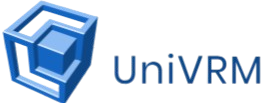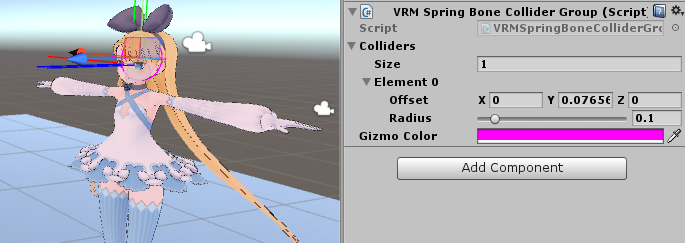UniVRM is a Unity-based plugin designed to support the VRM (Virtual Reality Model) format, a standard built on glTF 2.0 for representing 3D humanoid avatars. Developed by the VRM Consortium, UniVRM enables seamless import, export, and runtime usage of VRM models within Unity, making it an essential tool for creators working in virtual reality, gaming, and avatar-driven applications.
This open-source solution simplifies avatar integration by offering compatibility with VRM 0.x and 1.0, support for real-time model handling, and conversion between Unity shaders and PBR materials. UniVRM plays a key role in advancing cross-platform avatar interoperability and immersive content creation.
Origins of the VRM Format and glTF 2.0 Standard
The glTF (GL Transmission Format) 2.0 standard, created by the Khronos Group, is a royalty-free specification for the efficient transmission and loading of 3D models. It is often referred to as the “JPEG of 3D” due to its compact size and fast runtime performance. VRM builds upon glTF 2.0, adding custom extensions to support humanoid rigging, expressive facial animation, and application-level information. This foundation allows VRM to be lightweight and platform-agnostic while remaining highly extensible for animation-rich environments.
Role of the VRM Consortium in Development and Standardization
The VRM Consortium, a group of organizations and developers dedicated to advancing avatar technology, oversees the ongoing development of the VRM specification. They ensure consistent implementation across tools and platforms, coordinate updates to maintain compatibility with modern engines, and provide guidance on licensing and ethical usage. The consortium also manages official tools and libraries, including UniVRM, which is considered the reference implementation for Unity.
Overview of UniVRM
Definition: Unity Implementation of the VRM Standard
UniVRM is a Unity plugin that implements support for the VRM file format within the Unity ecosystem. It acts as the bridge between VRM specifications and Unity’s game engine capabilities. With UniVRM, developers can import, modify, and export VRM-compliant avatars directly within the Unity Editor or at runtime.
Purpose: Importing, Editing, and Exporting Humanoid 3D Avatars in Unity
UniVRM provides developers and content creators with the tools necessary to work with 3D avatars seamlessly. From importing VRM models to customizing rigging, blend shapes, shaders, and metadata, UniVRM ensures a smooth workflow from design to deployment. It supports both editor-based and runtime processes, enabling avatars to be dynamically loaded, modified, or exported in live applications such as games and metaverse platforms.
Licensing and Open-Source Nature (MIT License)
UniVRM is released under the MIT License, a permissive open-source license that allows developers to freely use, modify, and distribute the software in commercial and non-commercial projects. This openness has encouraged widespread adoption, community contributions, and the creation of a vibrant ecosystem around avatar development in Unity.
Key Features
Support for VRM 0.x and VRM 1.0
UniVRM maintains compatibility with both VRM 0.x and the more recent VRM 1.0 standard. This ensures backward compatibility for legacy content while embracing new features and optimizations introduced in the latest specification.
Integration with Unity Editor and Runtime Environments
UniVRM is fully integrated with Unity’s Editor, allowing developers to work with avatars using the familiar drag-and-drop interface. Additionally, it provides runtime APIs that enable dynamic avatar handling within applications. This dual functionality supports a broad range of development workflows, from static scenes to interactive, avatar-driven experiences.
Material and Shader Compatibility (Standard Shader to PBR Conversion)
To ensure visual consistency, UniVRM automatically converts materials from Unity’s Standard Shader to physically based rendering (PBR) equivalents compatible with glTF. This includes accurate rendering of textures, lighting, and transparency, enhancing the visual fidelity of imported models.
Real-Time Import/Export Using Async/Await
UniVRM supports asynchronous loading and saving of avatar files, making it possible to handle large VRM files without freezing or stalling applications. This is particularly useful in runtime scenarios where avatars need to be loaded dynamically, such as in VR chat applications or character customization menus.
Auto-Migration of Legacy Formats
With each update to the VRM standard, UniVRM provides migration tools to automatically update older VRM 0.x files to the newer 1.0 format. This ensures ongoing usability of existing assets and reduces the need for manual rework when transitioning to newer versions.
Supported File Formats
VRM (.vrm), VRM 1.0 (.vrm)
VRM files are the core format used for humanoid avatars. UniVRM can read and write both legacy and current versions of these files, enabling compatibility across generations.
glTF (.gltf/.glb)
As the underlying standard for VRM, glTF files are also supported by UniVRM. This allows developers to import base models or assets from third-party 3D tools and convert them into VRM avatars.
VRM Animation (.vrma)
UniVRM supports the VRM Animation format (.vrma), which encapsulates facial expressions, poses, and animations. This adds another layer of expressiveness and customization for avatar behavior.
Installation and Setup
Installation Methods
UniVRM can be installed via two primary methods:
- UnityPackage Import: Download precompiled packages from the official GitHub repository and import them into the Unity project manually.
- Unity Package Manager (UPM): Modify the
manifest.jsonfile in Unity’s project directory to include UniVRM and UniGLTF packages directly from GitHub.
Required Dependencies
To ensure full functionality, UniVRM requires the following packages:
- UniGLTF: For handling glTF file structures and conversions
- VRMShaders: To support custom shaders used in VRM models
Use Cases
VTubing and Digital Avatar Streaming
VTubers rely on UniVRM to manage and present expressive, personalized avatars during live broadcasts. The ability to customize facial expressions, body movements, and visual effects makes it a cornerstone tool for virtual content creators.
VR/AR/XR Apps Requiring Humanoid Models
In immersive environments, realistic and responsive avatars are essential. UniVRM enables developers to implement humanoid models in virtual and augmented reality experiences with high performance and visual integrity.
Social Metaverse Environments
Social platforms like virtual chatrooms or digital hangouts use UniVRM to populate worlds with interactive avatars. It provides the technical framework for loading, displaying, and animating characters within these real-time environments.
Game Development with Character Customization
Game developers use UniVRM to introduce detailed avatar customization systems. From basic outfit changes to advanced morph target blending, UniVRM provides the tools for deeply personalized gameplay experiences.
Platform Compatibility
UniVRM supports a wide range of target platforms, enabling flexibility in deployment:
- Desktop: Windows, macOS, Linux
- Mobile: iOS and Android
- Web: WebGL
Additionally, it is compatible with both Unity scripting backends—.NET and IL2CPP—ensuring that developers can choose their preferred performance and build configurations.
Community and Ecosystem
Official Documentation
The UniVRM team maintains comprehensive documentation that includes installation guides, API references, and model creation best practices. This ensures developers can quickly get up to speed.
GitHub Repository and Active Development
UniVRM is actively maintained by its contributors, with frequent updates that introduce new features, improve stability, and enhance performance. Developers can track issues, contribute code, or request features through the GitHub repository.
Community Support via Forums, Discord, and Tutorials
A vibrant community surrounds UniVRM, offering support through user forums, Discord channels, and tutorial content. This collaborative environment helps developers solve problems, learn new techniques, and stay updated on the latest developments.
Ecosystem Tools
UniVRM integrates seamlessly with popular avatar creation tools and exporters such as:
- VRoid Studio for character creation
- Blender with VRM export plugins
- VTuber applications for live broadcasting and real-time interaction
Conclusion
UniVRM represents a robust and forward-looking solution for integrating VRM avatars into Unity projects. Its comprehensive support for avatar standards, open-source nature, and cross-platform compatibility make it an indispensable tool for developers and content creators working in avatar-centric domains.
As the demand for personalized virtual identities grows, UniVRM continues to play a critical role in shaping the future of immersive content. Whether you’re developing a VR game, creating a VTuber persona, or building the next generation of social metaverse platforms, UniVRM provides the foundation for bringing humanoid avatars to life with precision and flexibility.

